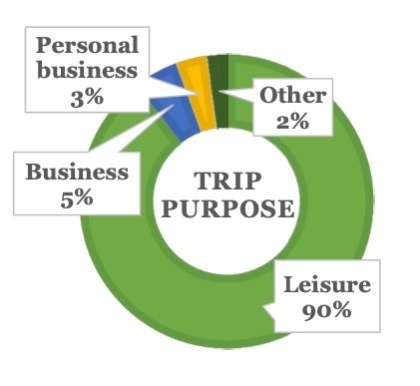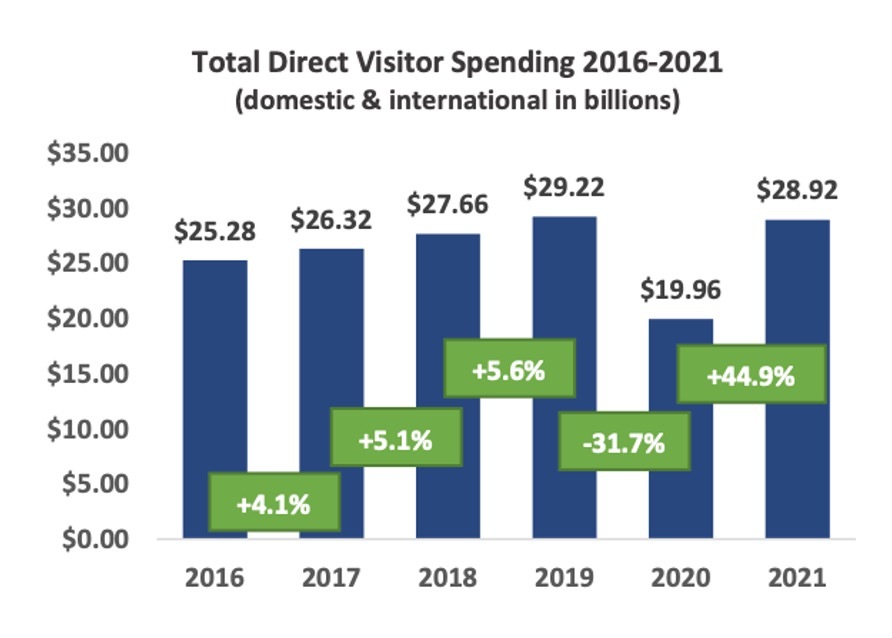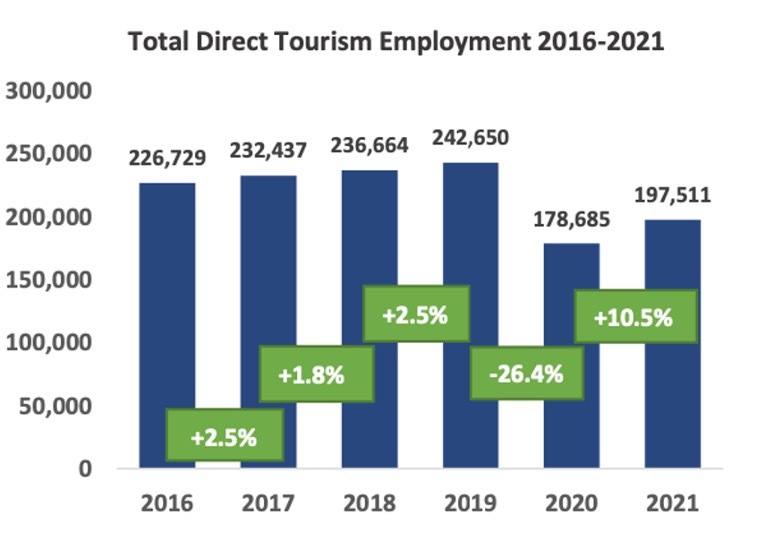- State visitor spending in 2021 would have needed to be another $2 billion higher to break even with the 2019 record
- Tourism jobs in 2021 were still 18% below pre-pandemic levels
- When the government stood between workers and their paychecks, the tourism industry was disproportionately harmed
Cooper’s lockdowns cost North Carolina’s tourism industry billions of dollars and half its jobs in 2020. Since then, how much has the state recovered?
North Carolina hosted nearly 45 million visitors in 2021 and was the fifth-highest in the nation for domestic visitation.
People are visiting NC in droves, mostly for leisure, which leans heavily on the tourism industry of foodservice, lodging, retail, and recreation.
North Carolina Visitor Profile 2021

Source: Screenshot from VisitNC.com
This is fantastic news for the state, but how does it compare to pre–pandemic lockdown levels? First, we will look at changes in visitor spending. Next, we will look at the tourism workforce.
Visitor Spending
According to the latest release from the North Carolina Department of Commerce, all 100 counties saw increases in visitor spending in 2021. Visitor spending is up 45% statewide from 2020 according to research commissioned by Visit North Carolina, a unit of the Economic Development Partnership of North Carolina, conducted by Tourism Economics.
Even so, the spending total of $28.9 billion fell roughly 1% below the 2019 record of $29.2 billion. Adjusting for inflation, however, paints a more realistic picture.
Using average CPI data for 2019 and 2021, prices increased by 6.0% from 2019 to 2021. In real terms, it means that in order to break even with the 2019 record, 2021 visitor spending would have needed to be another $2 billion higher.
As inflation wreaks havoc on family budgets, it is likely many families cut back on vacation spending.
International spending is only a small portion of overall visitor spending (4.5%) in 2019. Yet international spending alone was down 74.2% in 2021 since 2019, making up only 1.16% of total visitor spending.

Source: Screenshot from VisitNC.com
Tourism Workforce
Spending in 2021 was $2 billion short of 2019 totals when accounting for inflation, but what about the health of the tourism workforce?
Anecdotally, we know the workforce is struggling. Businesses are cutting hours because they are understaffed. Many restaurants now have walk-in interview options. Some companies are offering sign-on bonuses when they traditionally would not.
According to Visit NC, “The state’s tourism-supported workforce increased 10.5 percent to 197,500 jobs in 2021. That figure reverses the more than 26 percent loss in employment suffered in 2020. But the total remains 18 percent below the record 242,600 jobs from 2019.”

Source: Screenshot from VisitNC.com
Tourism is essential for many small businesses across the state. North Carolina Department of Commerce Secretary Machelle Baker Sanders said, “More than 45,000 small businesses across North Carolina rely on what visitors spend – on everything from lodging and dining to transportation, recreation and retail.”
When compared with 2020, each sector referenced by Visit NC showed job growth. But comparing 2021 to 2019 tells a different story: each sector lost jobs. Employment in recreation dropped 22.8%. Foodservice and lodging dropped 13.2% and 18.2%, respectively. Altogether, domestic tourism employment was down 15.7% when compared to the pre-pandemic year. International tourism employment dropped 77.3%.
One in 54 of North Carolinians were directly employed by tourism in 2021. In 2019, one in 45 were employed by tourism.
The national labor force is 3.25 million workers smaller than before the pandemic. Unfortunately, lower-wage tourism jobs are among the sectors hit the hardest.
Conclusion
During the pandemic, the government (federal and state governments in some cases) stood between workers and their paychecks and then paid them more than their wages with stimulus and unemployment benefits. Certainly, some workers have left their industries for better-paying jobs and more flexibility.
But overall, low-wage jobs, which include much of the tourism industry, have been slow to return, disrupting the entire sector. As with most government interventions, lower-paying sectors were disproportionately harmed by the pandemic lockdowns. If the government will step back and let the tourism industry thrive again, North Carolina will continue to be a treasured home and vacation destination for many.


